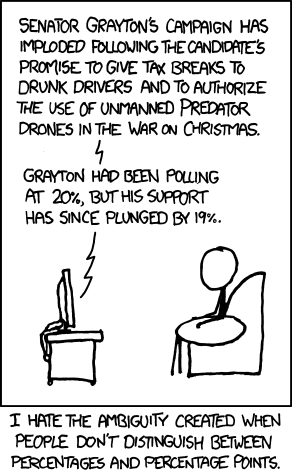Percentage point
Percentage point is a rather tricky beast. We use it all the time even if we don't know it - and in these situations we often incorrectly say percent instead of percentage point. Once you read this page, you will know how to do it properly and will be annoyed for the rest of your life (because other people will keep making the mistake).
Senator Homer Simpson was polling at 10% last month. He had a few successful debates since then and now 12% of the population wants to vote for him. What's the change? You want to say 2%, am I right? It's wrong! Let's examine this. Imagine the whole population is 1000 people. 10% of them is 100. 12% is 120. What's the percentage increase? It's 100 * 20 / 100 = 20%!

Source: XKCD.
This is when percentage points come in handy. We use percentage points when we want to talk about a change from one percentage to another. A change from 10% to 12% is 2 percentage points (or 20 percent).
Another way to think about a difference between a percentage change:
- percentage points change is that percentage change is in relation to the previous value (10% in our example... and one percent of that is one hundredth of 10% = 0.1%)
- change in percentage points is in relation to the whole part (whole being the whole population, or 1000 in our example. 1% of that is 10).
To calculate percentage points, simply subtract one percentage from another. 30% is 20 percentage points higher than 10%.
Percentage point can be abbreviated as pp.
Now that you know everything about percentage points I guarantee you that you will read or hear other people incorrectly saying percent when they should be using percentage points. If you're anything like me, you will scream at the newspaper, insulting it in some made up language. This helps freeing up space around you when you're using public transportation :).